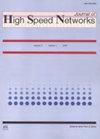IoT device type identification using training deep quantum neural networks optimized with a chimp optimization algorithm for enhancing IoT security
IF 1
Q4 COMPUTER SCIENCE, INFORMATION SYSTEMS
引用次数: 0
Abstract
IoT networks can be defined as groups of physically connected things and devices that can connect to the Internet and exchange data with one another. Since enabling an increasing number of internets of things devices to connect with their networks, organizations have become more vulnerable to safety issues and attacks. A major drawback of previous research is that it can find out prior seen types only, also any new device types are considered anomalous. In this manuscript, IoT device type detection utilizing Training deep quantum neural networks optimized with a Chimp optimization algorithm for enhancing IOT security (IOT-DTI-TDQNN-COA-ES) is proposed. The proposed method entails three phases namely data collection, feature extraction and detection. For Data collection phase, real network traffic dataset from different IoT device types are collected. For feature mining phase, the internet traffic features are extracted through automated building extraction (ABE) method. IoT device type identification phase, Training deep quantum neural networks (TDQNN) optimized with Chimp optimization algorithm (COA) is utilized to detect the category of IoT devices as known and unknown device. IoT network is implemented in Python. Then the simulation performance of the proposed IOT-DTI-TDQNN-COA-ES method attains higher accuracy as26.82% and 23.48% respectively, when compared with the existing methods.使用黑猩猩优化算法优化的训练深度量子神经网络进行物联网设备类型识别,以增强物联网安全性
物联网网络可以被定义为一组物理连接的事物和设备,它们可以连接到互联网并相互交换数据。由于使越来越多的物联网设备与他们的网络连接,组织变得更容易受到安全问题和攻击。先前研究的一个主要缺点是它只能找到之前看到的类型,而且任何新的设备类型都被认为是异常的。在本文中,提出了利用黑猩猩优化算法优化的训练深度量子神经网络来增强物联网安全性(IoT - dti - tdqnn - coa - es)的物联网设备类型检测。该方法包括数据收集、特征提取和检测三个阶段。数据采集阶段,采集不同物联网设备类型的真实网络流量数据集。在特征挖掘阶段,采用自动化建筑提取(ABE)方法提取互联网流量特征。物联网设备类型识别阶段,利用黑猩猩优化算法(COA)优化的深度量子神经网络(TDQNN)来检测已知和未知物联网设备的类别。IoT网络是用Python实现的。与现有方法相比,本文提出的IOT-DTI-TDQNN-COA-ES方法的仿真性能分别达到26.82%和23.48%。
本文章由计算机程序翻译,如有差异,请以英文原文为准。
求助全文
约1分钟内获得全文
求助全文
来源期刊

Journal of High Speed Networks
Computer Science-Computer Networks and Communications
CiteScore
1.80
自引率
11.10%
发文量
26
期刊介绍:
The Journal of High Speed Networks is an international archival journal, active since 1992, providing a publication vehicle for covering a large number of topics of interest in the high performance networking and communication area. Its audience includes researchers, managers as well as network designers and operators. The main goal will be to provide timely dissemination of information and scientific knowledge.
The journal will publish contributed papers on novel research, survey and position papers on topics of current interest, technical notes, and short communications to report progress on long-term projects. Submissions to the Journal will be refereed consistently with the review process of leading technical journals, based on originality, significance, quality, and clarity.
The journal will publish papers on a number of topics ranging from design to practical experiences with operational high performance/speed networks.
 求助内容:
求助内容: 应助结果提醒方式:
应助结果提醒方式:


